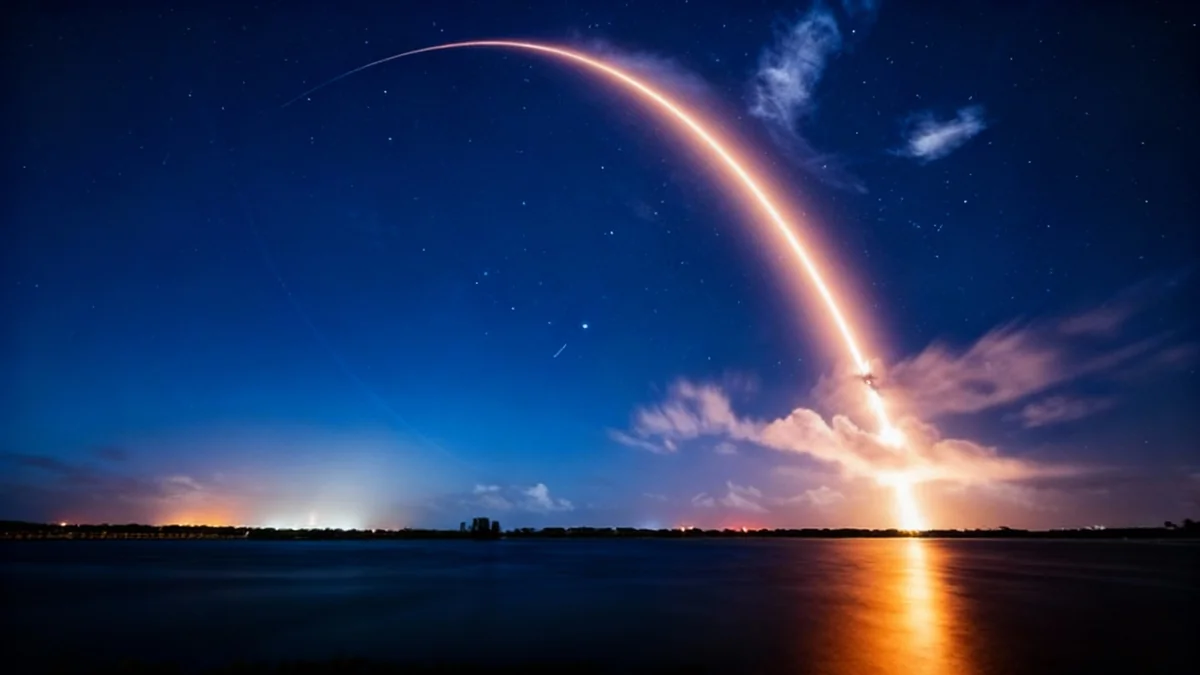SpaceX is scheduled to launch a Falcon 9 rocket from Cape Canaveral Space Force Station in Florida on October 6, 2025. The mission, designated Starlink 10-59, will carry 28 Starlink internet satellites into low Earth orbit. This launch marks the company's return to flight operations from the region after a delay of more than a week caused by persistent storms.
Key Takeaways
- Mission: Starlink 10-59 will add 28 satellites to the Starlink broadband constellation.
- Launch Vehicle: A Falcon 9 rocket using the first-stage booster B1090 for its eighth flight.
- Location and Time: Liftoff is targeted for 2:46 a.m. EDT from Space Launch Complex 40 at Cape Canaveral.
- Weather: The 45th Weather Squadron forecasts a 65% chance of favorable conditions, with liftoff winds as the primary concern.
- Booster Landing: The first stage is planned to land on the drone ship 'A Shortfall of Gravitas' in the Atlantic Ocean.
Mission Details and Launch Schedule
SpaceX has scheduled its next Starlink satellite deployment for the early morning hours of October 6, 2025. The launch window opens at 2:46 a.m. EDT (0646 UTC) from the historic Space Launch Complex 40 (SLC-40) at Cape Canaveral Space Force Station.
The mission's primary objective is to deliver another batch of 28 Starlink satellites to orbit. This flight is part of SpaceX's ongoing effort to build out its global satellite internet service, which provides high-speed, low-latency broadband to users worldwide.
A Return to Florida Launches
This mission is notable as it is the first Falcon 9 launch from Florida in over a week. A series of daily storms and unfavorable weather patterns across Central Florida and the Atlantic Ocean led to a temporary pause in the otherwise rapid launch cadence from the Cape.
Booster B1090 Makes Eighth Flight
For this mission, SpaceX will utilize its flight-proven Falcon 9 first-stage booster, B1090. This will be the eighth launch and landing attempt for this specific piece of hardware, demonstrating the company's commitment to reusability to lower the cost of access to space.
Booster B1090 has a diverse flight history, having supported a variety of missions. Its previous flights include:
- Crew-10 (a human spaceflight mission)
- CRS-33 (a cargo resupply mission to the International Space Station)
- Bandwagon-3 (a rideshare mission)
Automated Drone Ship Landing
Approximately eight minutes after liftoff, the first stage is expected to separate and perform a series of burns to guide itself back through Earth's atmosphere. The target for its automated landing is the drone ship named 'A Shortfall of Gravitas', which will be positioned in the Atlantic Ocean.
Landing Milestones
If the landing is successful, it will mark the 127th time a booster has landed on this particular drone ship. It will also be the 515th successful recovery of a Falcon booster overall, a key statistic in SpaceX's operational history.
Weather Conditions and Potential Concerns
The official weather forecast for the launch window is provided by the U.S. Space Force's 45th Weather Squadron. They have predicted a 65 percent probability of favorable weather conditions for liftoff.
In their official report, launch weather officers highlighted two main areas of concern. "The main concern for Tuesday morning’s launch attempt is liftoff winds, which may periodically exceed threshold," the forecast stated. The presence of cumulus clouds is the other potential issue that could violate launch criteria.
Meteorologists noted that while daytime shower activity has been enhanced by deep tropical moisture, this activity is expected to decrease by the time the launch window opens, improving overall conditions.
Expanding the Starlink Constellation
The Starlink 10-59 mission is the 90th launch dedicated to the Starlink project in 2025. Each successful launch significantly expands the capacity and coverage of the satellite internet network.
"Prior to this launch, SpaceX has more than 8,500 Starlink satellites in low Earth orbit."
This data comes from Jonathan McDowell, a respected astronomer and expert tracker of orbital objects. The addition of 28 more satellites will further bolster the megaconstellation, which continues to be one of the most ambitious satellite deployment projects in history.
The company aims to provide global internet coverage, including to rural and underserved areas where traditional internet infrastructure is unreliable or nonexistent. The continuous expansion of the satellite network is critical to achieving this long-term goal.





